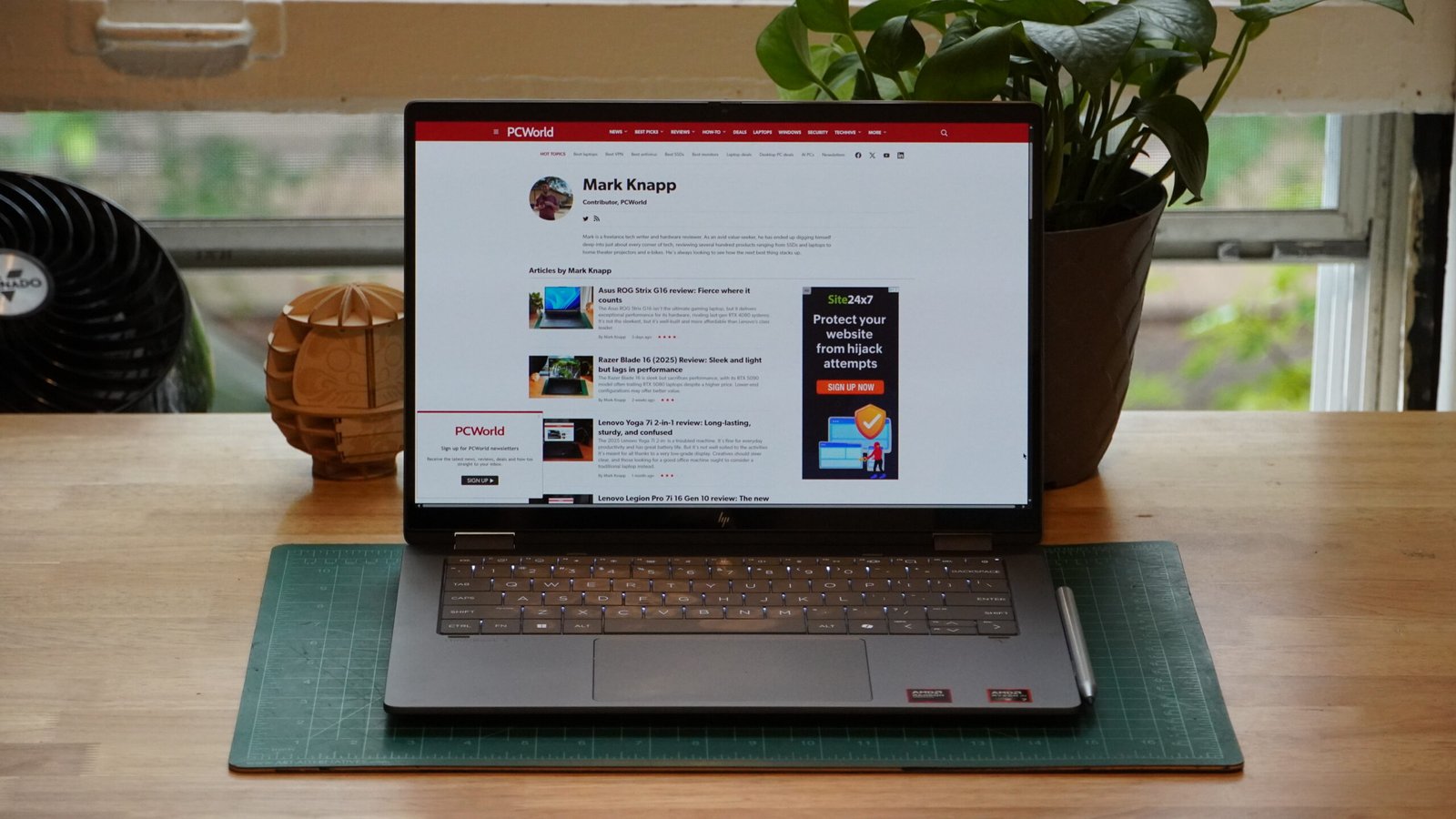Expert’s Rating
Pros
- Solid CPU performance in its class
- Sturdy metal build
- Excellent 120Hz OLED display
Cons
- Battery life comes up lacking
- Weak iGPU versus Intel Arc
- Tricky keyboard
Our Verdict
The HP OmniBook X Flip 14 is a capable enough 2-in-1, with ample CPU performance and a gorgeous display. But it’s a little bit boring, has a troubling keyboard, offers weak iGPU performance, and sacrifices battery life. To still have a $1,509 price tag with that many trade-offs puts it in a tough position.
Price When Reviewed
This value will show the geolocated pricing text for product undefined
Best Pricing Today
Best Prices Today: HP OmniBook X Flip 14
The HP OmniBook X Flip 14 is here to stretch the OmniBook family even further. The branding was reintroduced alongside the introduction of Microsoft’s Copilot+ PCs, set to usher in a new era of AI-powered systems. To that end, the HP OmniBook X Flip 14 features either a recent AMD Ryzen AI chip or an Intel Core Ultra 200-series chip, both of which have NPUs on deck. That said, plenty of other systems are doing the same thing, and the utility remains questionable.
Beyond this AI-everywhere bandwagoning, the HP OmniBook X Flip 14 is actually a fairly straightforward 2-in-1, and it has the looks of one. It’s a higher tier among OmniBooks, which means it comes with price tags ranging from $1,000 and up. The competition gets fierce once you break $1,000. And the HP OmniBook X Flip 14 has a hard time proving it merits the price tag. It’s a fine laptop, but it has little beyond a great display to get excited about.
HP OmniBook X Flip 14 : Specs and features
- CPU: AMD Ryzen AI 7 350
- Memory: 32GB LPDDR5x-7500
- Graphics/GPU: AMD Radeon 860M
- Display: 14-inch 2880×1800 OLED touchscreen, glossy
- Storage: 1TB PCIe Gen4 SSD
- Webcam: 5MP + IR
- Connectivity: 1x USB4 Type-C with Power Delivery and DisplayPort 2.1, 1x USB-C 10Gbps with Power Delivery and DisplayPort 2.1, 2x USB-A 10Gbps, 1x HDMI 2.1, 1x 3.5mm combo audio
- Networking: WiFi 7, Bluetooth 5.4
- Biometrics: Windows Hello facial recognition
- Battery capacity: 59 watt-hours
- Dimensions: 12.32 x 8.60 x 0.7 inches
- Weight: 3.12 pounds
- MSRP: $1,509 as-tested ($1,099 base)
The HP OmniBook X Flip 14 clearly has enough might to keep up with general workloads.
The HP OmniBook X Flip 14 launched with a stated starting price of $1,099 at Best Buy. That configuration provides an AMD Ryzen AI 7 350 chip with 24GB of memory, 1TB of storage, and a 1920×1200 IPS touchscreen. HP offers its own configurations, which actually start with lower-end specs than that for $1129. HP includes upgrade options to the memory and display. Our test configuration represents the highest spec, coming with 32GB of memory, 1TB of storage, and a 2880×1800 OLED display. As tested, the system costs $1,509.
Separate from this, HP has an Intel-powered version which it interestingly has at a lower $999 starting price. While we can’t determine how similar the two versions are without testing, it’s a solid guess that the Intel version has better graphics, worse CPU performance, and longer battery life based on everything we’ve been seeing from the latest systems running Intel and AMD mobile chips.
Even though the HP OmniBook X Flip 14 has just launched, HP has already begun offering discounts. I’ve spotted it going for as much as $500 off.
HP OmniBook X Flip 14 : Design and build quality
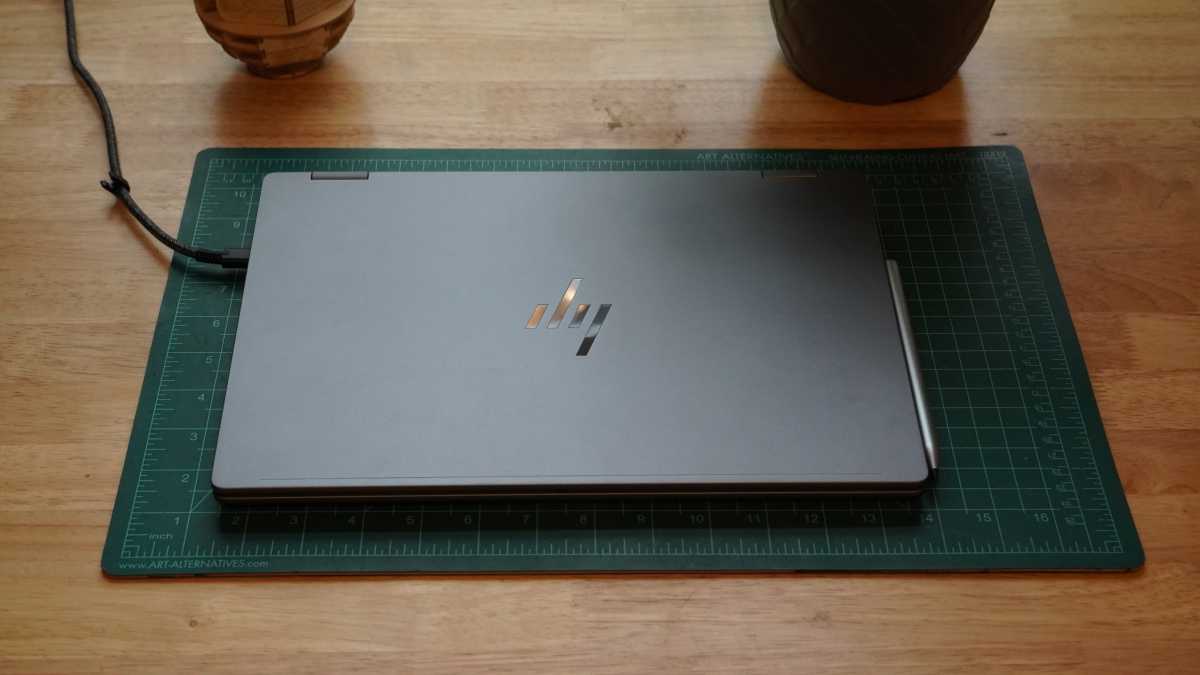
IDG / Mark Knapp
The HP OmniBook X Flip 14 is a refined but simplistic two-in-one laptop. It has nicely rounded corners and smooth edges for comfort, but it’s fairly plain to look at. Perhaps the only little bit of real visual intrigue is the lattice-less keyboard, but that comes with its own downsides, which we’ll get into later.
Included in that nice build is an expansive use of aluminum, which is anodized and sandblasted, giving it a pleasingly smooth texture. The HP OmniBook X Flip 14 still has subtle flex here and there, but feels plenty rigid. It should feel sturdy, though, as it’s not exactly thin or light for a 14-inch laptop, measuring 0.7 inches thick and 3.12 pounds.
Though laptops have come a long way in trimming the excesses in their designs, the HP OmniBook X Flip 14 isn’t quite there. It has relatively thick top and bottom bezels, around its display and an extra little strip of plastic below the display. As a result, it doesn’t feel quite as futuristic as something like the XPS 13.
In between the base of the laptop and the display, you’ll find the typical 360-degree hinges on either side, which allow the laptop to flip over into tent mode and tablet mode. To help keep the HP OmniBook X Flip 14 in its tablet position, HP has integrated strong magnets that hold it open so the display doesn’t flop around. These magnets also serve to keep the lid closed when the laptop is stored away. The lid doesn’t have a very good lip to get ahold of when trying to open the laptop, and with the fairly firm hinge, the magnets, and light base, it becomes difficult to get the laptop open. If I had shorter fingernails, I think I’d truly struggle getting it open.
The HP OmniBook X Flip 14 works with a stylus, too. HP’s included stylus latches onto the side of the system using the magnets as well. This can be reasonably secure, as long it’s in the correct position. The thing is, the stylus is happy to latch on loosely in several other positions.
The laptop sits on very thin, long rubber feet that barely lift the base up at all. This creates a very small channel for airflow while simultaneously not creating much surface area to get traction on tables or desks. While normally it would be a little bit concerned about this kind of constraint, the fact is that the grille underneath only provides a small hole for airflow, and is likely the limiting factor. It’s curious that there is such a wide grille on the underside, as much of it seems to lack purpose. Even where the fan is located, HP has taped off some of the grille, so only a portion of the fan is able to pull air in. Given all that, it’s not surprising that the HP OmniBook X Flip 14 can get a bit warm in everyday use.
Above the display, HP fits a small webcam with a privacy shutter. But the shutter has black and white stripes on it that can be hard to distinguish from glare, rather than an easy-to-see red dot like some of its competitors.
HP packs the laptop’s speakers into slits that sit along the front edge of the laptop. This somewhat cleverly sees them face forward in the laptop position, tent position, and tablet position (if you have them turned to face you).
HP OmniBook X Flip 14 : Keyboard, trackpad
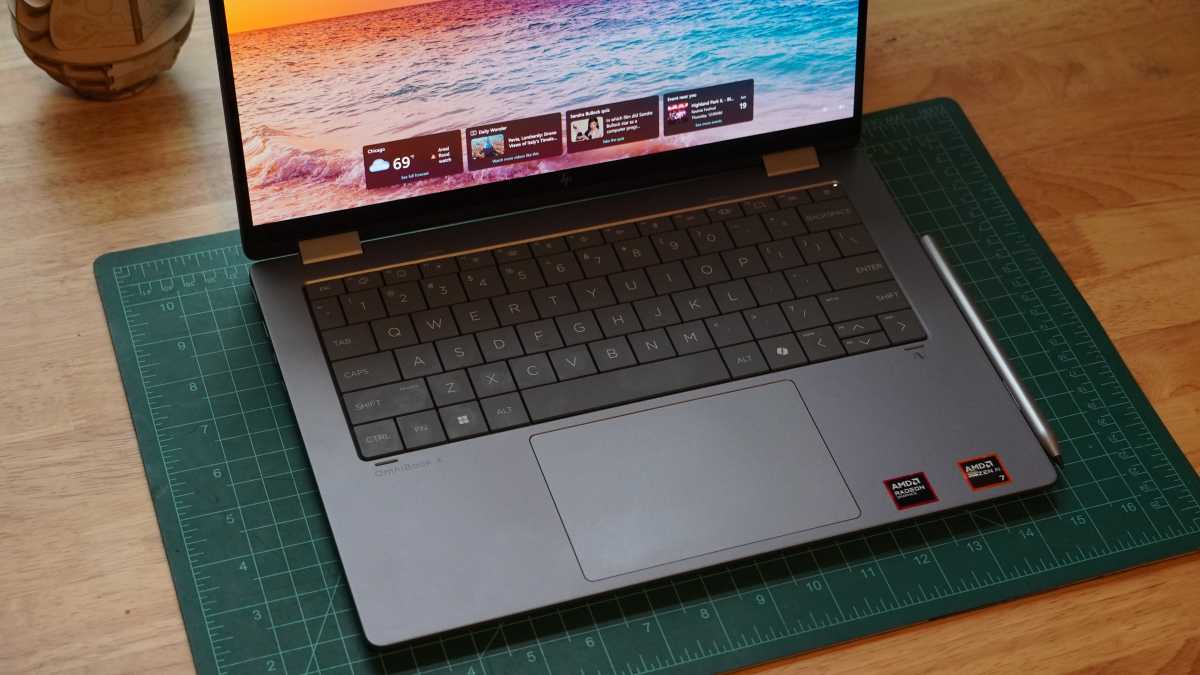
IDG / Mark Knapp
HP had a decent keyboard on its hand with the 2024 introduction of its OmniBook lineup. But this year, HP has taken a page — the worst page — from Dell’s playbook and tried copying the near gapless design of its recent XPS laptops while also ditching the fun multi-color design it had started out with. The result is a packed-in keyboard with very flat keys and little contouring to feel out what you’re typing on. While it’s still possible to type by feel, if you have a tendency to drift slightly, as I do, you may struggle to regularly recalibrate because you won’t feel the edges of the keys. The extra width of the keycaps also makes them simply less stable than they might otherwise have been.
I did manage 107 words-per-minute at 98 percent accuracy in Monkeytype, but it felt like I was rushing the whole time, and the keys simply didn’t have the greatest feel. When typing quickly, the actuation and bottom-out point don’t end up feeling very distinct.
The trackpad is a better experience. It’s sizable for a 14-inch laptop, lets my fingers glide along smoothly, and has a gentle hardware click with a shallow travel. It’s nothing fancy, but it gets the job done.
HP OmniBook X Flip 14 : Display, audio
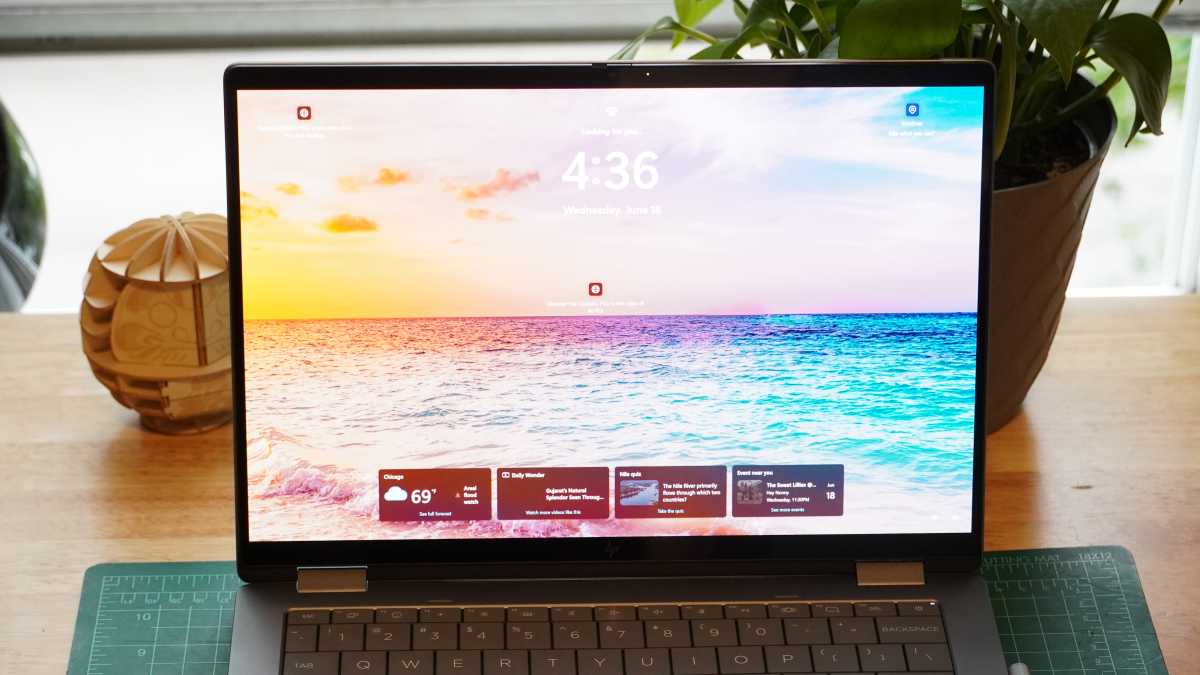
IDG / Mark Knapp
The HP OmniBook X Flip 14 packs in an exceptional display. It packs in a resolution of 2880×1800 onto its 14-inch panel. This is an OLED display that’s capable of reaching 395 nits (for a full white screen) alongside infinite contrast. And it’s very colorful, achieving 100 percent coverage of the DCI-P3 color space. that color is largely accurate as well with the average Delta E of 0.94 and a max of 2.4. To top it off, the panel is capable of going up to 120Hz and supports VRR down to 48Hz. All of this combines to make for a display that looks great for just about anything you’re doing. Movies and TV will look good, games are vibrant and smooth, and everyday office work just pops a little bit more. It is glossy, though, which can make it hard to see with bright ambient lighting.
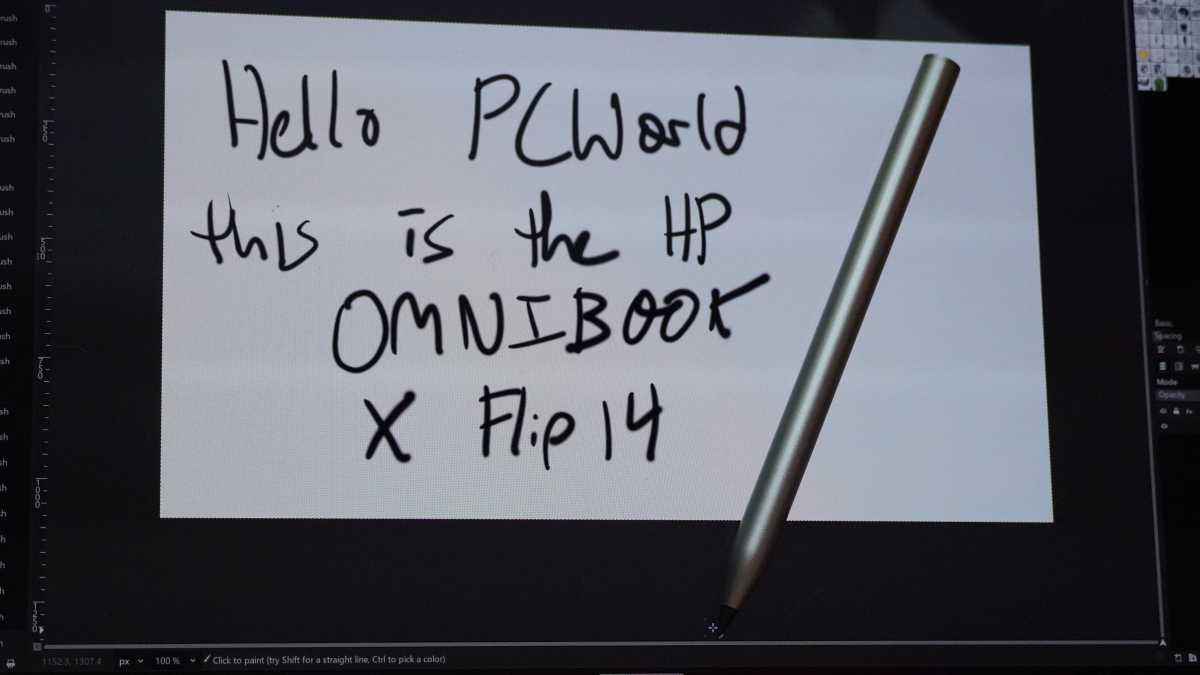
IDG / Mark Knapp
The display isn’t just an output either. It has touch input allowing for quick selection and easy scrolling. And it works with HP’s included stylus. I find the stylus quite responsive, making for easy and precise input. But I struggle to avoid touchscreen inputs while using the stylus. Some sort of better palm rejection or a quick toggle to disable the touchscreen but keep the stylus functioning would be a big help.
The HP OmniBook X Flip 14 speakers produce nice and clear sound, even at its max volumes. They do get a touch harsher at high volumes, but they’re not terrible. The speakers lack much bass, which leaves music and movies feeling a bit flat. But they’re a solid choice for listening to speech and presentations.
HP OmniBook X Flip 14 : Webcam, microphone, biometrics
The webcam on the HP OmniBook X Flip 14 produces sharp video that looks quite good for a laptop’s built-in camera. Brightness levels can shift around a bit as the camera makes on-the-fly exposure adjustments, and it doesn’t always get it right on the first try, but it hasn’t looked outright bad in my testing. The camera also provides facial recognition for Windows Hello authentication.
The mic array does a stellar job focusing in on my voice. Even with a fan blowing hard just a foot away from the laptop, it only picked up my voice. I could clap loudly in front of the laptop while I spoke as well, and the mics would still only pick up my voice. And even with their noise suppression, my voice sounded clear and not digitized in any meaningful way.
HP OmniBook X Flip 14 : Connectivity
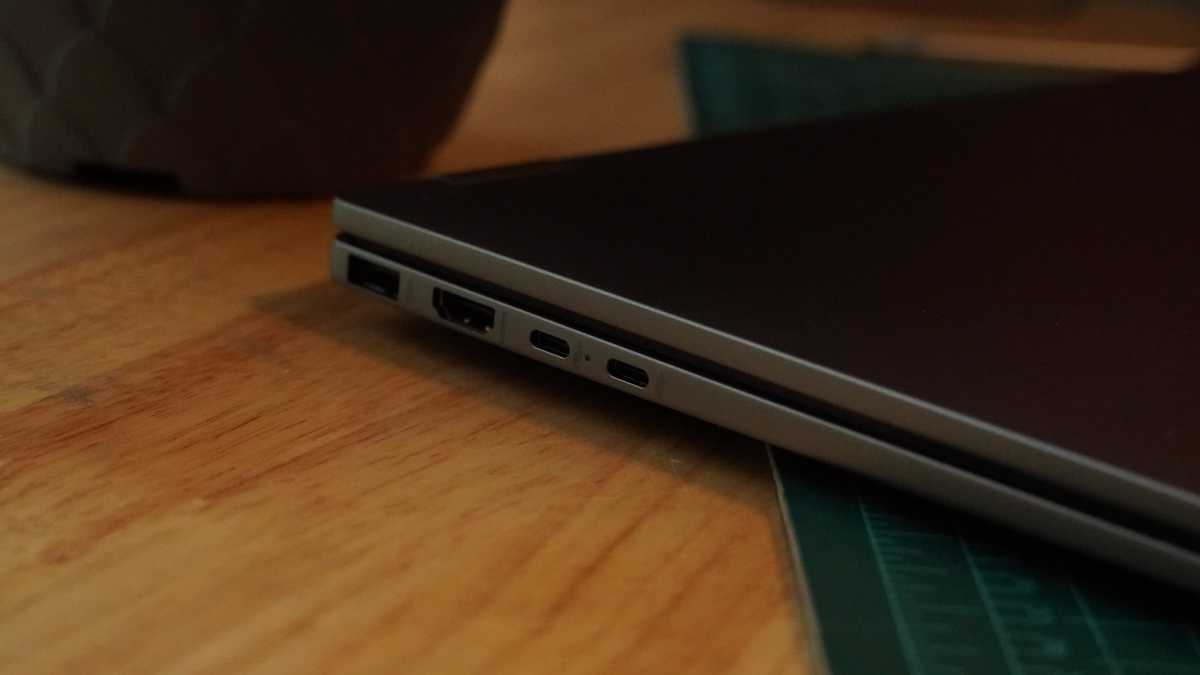
IDG / Mark Knapp
Despite being a much smaller system than the Flip 16, the HP OmniBook X Flip 14 actually features the same number and types of ports. That gives you two USB-C ports, an HDMI 2.1 port, and a USB-A port on the left side. And on the right side, you’ll find another USB-A port and a 3.5mm headphone jack. One of the Type-C ports offers USB4 speeds while the other is limited to 10Gbps, but both support power delivery and DisplayPort 2.1. Both USB-A ports also can reach 10Gbps.
For wireless connections, the HP OmniBook X Flip 14 uses Wi-Fi 7 and Bluetooth 5.4. In my time testing, I’ve never struggled to get the laptop online, and have enjoyed fast internet speeds, with the laptop readily taking advantage of my fiber internet connection.
HP OmniBook X Flip 14 : Performance
The HP OmniBook X Flip 14 has the makings of a fairly potent 2-in-1 with its AMD Ryzen AI 7 350 processor and 32GB of memory. But its pricing leaves it wide open to competition. The Dell 14 Plus 2-in-1 only lags a bit behind in terms of specifications and may make sacrifices in its bill of materials, but it costs less than half as much.
The MSI Summit 13 AI+ Evo brings the rival Intel Core Ultra 7 258V, as much RAM, double the storage, a bigger battery, a slightly smaller size, and a comparable aluminum build all for $1,499, though it doesn’t get the sharp OLED panel. Lenovo offers a compelling alternative in the ThinkPad X1 2-in-1 Gen 10 Aura Edition, which was $2,336 as tested and well equipped, albeit only with a 1200p IPS display (though a low-power one with an excellent anti-reflective finish). And Lenovo has a knack for discounting its ThinkPad prices by almost inconceivable amounts (if you can wait a few months).
But perhaps the HP OmniBook X Flip 14’s biggest threat comes from the Asus ProArt PX13, another little 2-in-1 that tucks in a more powerful AMD Ryzen AI 9 HX 370, an RTX 4050, 32GB of memory, 1TB of storage, a 2880×1800 OLED display of its own for $1,699, a price that’s way too close to the HP OmniBook X Flip 14’s for comfort.
The kit inside the HP OmniBook X Flip 14 gives it respectable performance. Its processor can cruise along in daily operation and light productivity workloads quite well, and we see that confirmed by the holistic PCMark 10 benchmark. Here, the speed of the CPU, storage, and integrated graphics all weigh into the score, and the HP OmniBook X Flip 14 clearly has enough might to keep up with general workloads.
A score of 5,000 is pretty good, but the HP OmniBook X Flip 14 goes well beyond that. That said, the HP OmniBook X Flip 14 really only leaves the Dell in its dust, as MSI’s laptop is very close in performance and largely held back by its slower storage. Lenovo and Asus both get away from the HP OmniBook X Flip 14, with Lenovo benefiting from even faster storage and stronger integrated graphics and the Asus ProArt PX13 leveraging its RTX 4050 for a big leg up in content creation.
When it comes to raw CPU performance, the HP OmniBook X Flip 14 benefits greatly from the AMD Ryzen AI 7 350. This recent lineup of AMD CPUs offers excellent single-core performance that comes close to matching Intel’s, but it also delivers a ton of cores to really power through multithreaded workloads. We see that clearly in our Handbrake test, which encodes a large video file. The eight cores (all with multithreading capabilities) zoom past the Intel Core Ultra 7 258V.
Even Dell’s six core CPU gets out ahead of the Intel Core Ultra 7 258V. But the HP OmniBook X Flip 14 is still outdone by the Asus ProArt PX13, which puts its 12-core AMD Ryzen AI 9 HX 370 to work. The results are actually somewhat surprising, as thermal throttling in this test can make some “more powerful” machines still fall by the wayside. So the fact the compact ProArt PX13 still manages to lead the pack here is a good indicator not only of its CPU performance but of Asus’s cooling and power management.
Cinebench can show us a bit more about the CPU performance of each machine, measuring burst speed in earlier versions of the benchmark, helping highlight throttling in Cinebench R24, and providing both single- and multi-core performance measurements. The HP OmniBook X Flip 14 consistently leads the Dell, Lenovo, and MSI systems for multi-core performance, though its lead narrows in Cinebench R24, likely due to its meager cooling system. But again, we see the HP OmniBook X Flip 14 fall way behind the ProArt PX13, which keeps its CPU cruising far ahead of the pack, only ever lagging behind in Cinebench R24’s single-core test, where it just narrowly trails the Intel-based systems.
As great as they are for CPU performance, the recent AMD chips just aren’t offering integrated graphics as solid as Intel’s Arc iGPUs. This sees the tables turn for the HP OmniBook X Flip 14, which falls way behind the Lenovo and MSI systems in 3DMark’s Time Spy benchmark. That same weakness hits the Dell even harder, but not the Asus. Since the ProArt PX13 can turn to its RTX 4050 instead of its integrated graphics, it not only leaps ahead of the HP OmniBook X Flip 14 but also soars past the MSI and Lenovo systems by a mile.
Even though the HP OmniBook X Flip 14 is a decent performer, seeing it so consistently and thoroughly shown up by the Asus ProArt PX13 — a machine that’s less than $200 more expensive — puts it in a tough spot.
HP OmniBook X Flip 14 : Battery life
The hope is that for every shortcoming in performance will be made up for in efficiency. That’s a hope largely realized by the Lenovo ThinkPad X1 2-in-1 Gen 10 Aura Edition and MSI Summit 13 AI+ Evo. While they struggled to get ahead of the HP OmniBook X Flip 14 in performance, they benefited from excellent battery life. The MSI system managed over 21 hours in our battery test, and Lenovo’s dazzled us with over 24.5 hours, even with just a 57Wh battery — the smallest of the bunch. The HP OmniBook X Flip 14 almost doesn’t even deserve to be compared to them, as it fell short of 11 hours.
Even the Dell stepped up with over 15 hours, though that’s still a meager result for recent laptops. What is perhaps most astounding is that the Asus ProArt PX13 yet again got ahead of the HP OmniBook X Flip 14. Asus managed over 14 hours. Somehow, that little Asus system — which is smaller and lighter than HP’s — managed to pack in a more potent CPU, a discrete GPU, a bigger battery to let it run faster and longer than the HP OmniBook X Flip 14.
Local video playback tests are also rather favorable tests, especially when a display can slow down its refresh rate and turn off pixels to display black letterboxing, as is the case for the HP OmniBook X Flip 14. In real world use, with Wi-Fi on, plenty of tabs going in Chrome, and plenty of white on the screen, battery life can drop. I found the HP OmniBook X Flip 14 up to the task of getting through an eight hour workday, but only with some hand-holding and a slightly dimmed display. If I wasn’t careful, it would fall a bit short.
HP OmniBook X Flip 14 : Conclusion
The HP OmniBook X Flip 14 is fine, but it just doesn’t have the sauce. It provides respectable performance and a gorgeous display, but trades battery life to deliver that. While Windows laptops have been seeing leaps and bounds forward in terms of battery life, the HP OmniBook X Flip 14 fails to take much more than a few steps forward. The AMD processor is part to blame, but HP bears some responsibility as well.
When you then factor in that the system is a little boring, has a contentious keyboard, and comes with a price tag that puts it in dangerous waters, it just becomes a laptop that’ll be easy to overlook. When Asus can pack in a better CPU, discrete graphics, and make its system run longer for close to the same price, what shot does the HP OmniBook X Flip 14 really have? The answer: not a very good one, unless HP wants to keep the huge discounts it was offering toward the tail end of my testing.
This articles is written by : Nermeen Nabil Khear Abdelmalak
All rights reserved to : USAGOLDMIES . www.usagoldmines.com
You can Enjoy surfing our website categories and read more content in many fields you may like .
Why USAGoldMines ?
USAGoldMines is a comprehensive website offering the latest in financial, crypto, and technical news. With specialized sections for each category, it provides readers with up-to-date market insights, investment trends, and technological advancements, making it a valuable resource for investors and enthusiasts in the fast-paced financial world.
